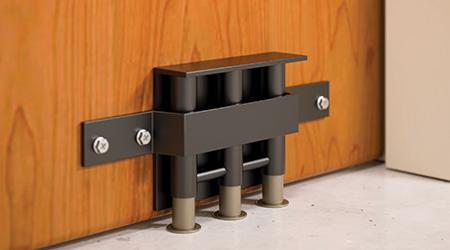
The 2018 model codes will reinforce the existing model code requirements for egress. In addition, a change will require classrooms and other lockable rooms in educational occupancies to be unlocked from the outside with a key or other approved means.
Removing Barricades to Life Safety
April 12, 2017
Everyone is familiar with the term barricade; a barricade is built to prevent people from entering or exiting an area. It is perhaps odd, then, that such a term has been used so frequently in discussions around security and safety in schools.
The very idea of a barricade is antithetical to the concept of ensuring free egress for building occupants. But for the last several years, code officials have been under intense pressure in some regions to allow schools to enhance the security of classroom doors by installing retrofit security devices, often called classroom barricade devices.
Designed to lock down a classroom door during an active shooter event, these devices are touted as being both effective and inexpensive — a very appealing combination to cash-strapped school districts that are under pressure from parents to enhance classroom security. Unfortunately, many of these products not only violate current life safety code requirements, they could also result in increased risk and liability.
Code Conflicts
In most of the United States, the model codes that have been adopted include the International Building Code (IBC), the International Fire Code (IFC) and/or NFPA 101 - The Life Safety Code. These codes prohibit any door in a means of egress to require more than one operation to release the latch(es). In addition, these codes mandate that hardware must be operable with no tight grasping, pinching, or twisting of the wrist, and without a key, tool, special knowledge or effort.
Many code officials have responded to questions about school security by reiterating that all egress doors,
including classroom doors, must meet the requirements of the adopted codes. But during the code development cycle for the 2018 edition of the model codes, a handful of states and local jurisdictions began issuing their own directives on classroom security. One unfortunate example can be found in Arkansas, where the state Senate voted unanimously to amend the fire code requirements and allow the use of barricade devices despite the strong objections of their state fire marshal.
The end result has been a number of inconsistencies from one state to the next, and even greater variations between school districts where conditional use of retrofit security devices is allowed. First responders could arrive on-scene without knowing what to expect and without the tools needed to access rooms equipped with classroom barricade devices. In addition to impacting evacuation, this can also create a situation where a person barricades the door with hostages inside, and there is no means of entry for authorized personnel.
Restoring Balance
Recognizing the vital need to restore the balance between life safety and security in schools, the Builders Hardware Manufacturers Association (BHMA) Codes and Government Affairs Committee created a consistent set of code requirements which have been approved for inclusion in the 2018 edition of the International Building Code. A corresponding change was also approved for the International Fire Code and a similar proposal is currently in progress for NFPA 101 -
The Life Safety Code.
The 2018 edition of the IBC will include the following section to address school security:
1010.1.4.4 Locking arrangements in educational occupancies. In Group E and Group B educational occupancies, egress doors from classrooms, offices and other occupied rooms shall be permitted to be provided with locking arrangements designed to keep intruders from entering the room where all of the following conditions are met:
1. The door shall be capable of being unlocked from outside the room with a key or other approved means.
2. The door shall be openable from within the room in accordance with Section 1010.1.9.
3. Modifications shall not be made to listed panic hardware, fire door hardware or door closers.
1010.1.4.4.1 Remote operation of locks. Remote operation of locks complying with Section 1010.1.4.4 shall be permitted.
This language will apply to classrooms, offices and other occupied rooms in K-12 schools, colleges, and universities. Rooms must be able to be unlocked from the outside and they must meet the current requirements for egress — one operation to unlatch the door, without requiring keys, tools, special knowledge or effort, and no tight grasping, pinching or twisting. No modifications are permitted to any listed panic hardware, fire door hardware or door closers. Remote operation is acceptable if the locks meet the other requirements of this section.
Code Compliant Alternatives
The idea that barricading the door is the only way to protect students and teachers in the classroom is a misconception. There are code-compliant locks readily available from many lock manufacturers that provide the needed security without compromising safety. There are also other aspects of classroom security to consider, such as the door, frame, glass, key distribution, communication and lockdown procedures. Many school security experts recommend classroom security locks, which can be locked from within the classroom using a key (mechanical locks) or electronic fob (electrified locks).
There are a number of code compliant options for enhancing security, depending on existing conditions, the needs of the facility, and the budget. But all lock functions that would typically be installed on a classroom door allow free egress as well as authorized access by staff and emergency responders.
By focusing solely on the unlikely scenario of an active shooter attempting to gain access to a classroom, little consideration is given to what might happen if barricade devices are deployed and the occupants inside suddenly needed to evacuate. While these devices may be effective at keeping an attacker at bay, many of them can also make it more difficult for first responders to enter. In addition, there is no guarantee that these retrofit devices would only be deployed in an emergency situation and, in fact, there is a much greater chance that they would be misused by the students themselves.
When working to increase the security of an educational facility, or any type of building, an all-hazards approach should be taken, considering not just active shooters and terrorism, but also fire, severe weather, natural disasters and other types of emergencies. The requirements for free egress, fire protection and accessibility must always be considered in conjunction with the need for security.
Lori Greene, AHC/CDC, CCPR, FDAI, FDHI, is manager of Codes & Resources for Allegion. For more information about this topic and to download a free reference guide on codes, visit iDigHardware.com/guide.
This Quick Read was submitted by Naomi Millán, senior editor of Building Operating Management magazine, naomi.millan@tradepress.com. For more information on doors and door hardware, go to https://www.facilitiesnet.com/doorsHardware/
Next
Read next on FacilitiesNet












